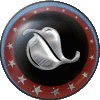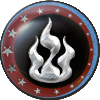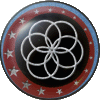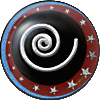The Unified Theory of Magic
|
Long ago, in a time before recorded history, magic on the world of Lyran Tal was chaotic, wild and dangerous. But then came a time of great changes throughout the lands, among them the arrival of the elves in Hyathis. For reasons that remain very much a mystery, a New Age was born, along with the Seven Gifts that form the basis of Lyran Tal magic today. An Introduction to Lyran Tal MagicMagic in Lyran Tal comes from the ley lines, which have been likened to a vast web of magic, interlocking strands or streams of raw power crisscrossing the entire planet. These lines move and shift constantly, but slowly. The Dwarves of Dvarnia's hold claim that there are concentrated lines of power deep underground, but it is unknown how--or if--they affect the overall workings of magic. To a lesser extent magic suffuses all things: the pure elements, the life force of an individual, and even the realm of decay and death. |
The Seven Gifts |
There are seven spheres of magic, also known as Gifts, each providing a particular focus that allows a magic-user to employ the magic without bringing about their own destruction or insanity. To attempt to draw upon the Ley Lines without such a focus (sometimes called a 'link'), the magic-user risks being blasted by the chaotic nature of the pure, raw energies.
To practice one of the Seven Gifts, one must be born with the ability to touch the Ley Lines, and thus instinctively be able to draw upon the specific elemental energy used in his or her sphere. (i.e. One is born a with the gift of Vivomancy, one does not choose it.) It is not always easy to identify mages until their particular gift begins to manifest, usually around the time a child reaches puberty. Curiously, the use of magic -- particularly noticeable in high-ranking mages -- frequently causes mages to age more slowly than others. Magic users are referred to as either mages or 'mancers.' Six of the seven Gifts are well-studied throughout the Silver Moon Empire. These are:
- Geomancy (the 1st Gift). Focus: nature and earth
- Aeromancy (the 2nd Gift). Focus: air
- Hydromancy (the 3rd Gift). Focus: water
- Pyromancy (the 4th Gift). Focus: fire
- Vivomancy (the 5th Gift). Focus: the positive energies of life
- Necromancy (the 6th Gift). Focus: the negative energy of death
The Seventh Gift (named 'Animancy' by scholars, though this term is almost never used by anyone else) uses the 'essence' of existence (made up of spirt, mind, and body) as its focus. Very little is known about this rare Gift.
Since each Gift utilizes a specific element in the Ley Lines, the theory of magic use cannot be taught generically. That is to say, for example, that a Pyromacer using fire can't teach a Hydromancer how to focus through water, because each gift has its own spells and techniques. A Pyromancer's spells will always manifest using some form of fire or manipulation of the fire element. There are certain 'generic' spells (such as teleportation or divination) which can be accomplished by any sufficiently trained mancer, but these must still incorporate the mancer's respective element.
Each region within the Silver Moon Empire, with the exception of Shadokhan, holds a natural prevalence of one Gift or element. Some theorize that it is the abundance of a particular element in one region (the abundance of water in Oceanuus, for example) that makes the Gift with that elemental focus much more potent in that specific region. While a mage of any Gift can draw power from the Ley Lines within any region, a mage casting within the region where his particular element is strongest has a more powerful link. Geomancers, for instance, are strongest within Arboria, where the elements of earth and nature are most abundant. It is rumored that within the Badlands (east of the Silver Moon Empire) these clear definitions of elemental magic are not the rule. Some scholars suggest that the Ley Lines in the Badlands shift chaotically, making it impossible for any particular area to become stronger in any one element than another.
The correspondence of region to element is as follows:
- Arboria: Geomancy
- Cloosidian: Aeromancy
- Oceanuus: Hydromancy
- Thermador: Pyromancy
- Luminii: Vivomancy
- Balthazor: Necromancy
Animancy is the only gift that is not supported by one particular region.
The Seven Gifts
Those wishing to write for a mancer should refer to the expanded version of the particular magic sphere of their mage character for more detailed information about how the magic works and the training that is required. A brief breakdown of the seven gifts is as follows:
The Geomancers have mastery over anything that can be done with earth or nature, including gems, crystals, minerals, metals and plant life. Geomancy, as taught at the Torrea Talamh in Cennebrae, Arboria, falls under the strict guidance of the elven Archmage, Tequin Shaldolf-Sundew. (For further information, see: Geomancy.)
The Aeromancers have mastery over anything that can be done with air. The most powerful Aeromancers can even affect weather, to a limited extent. Aeromancy, as taught within the borders of Cloosidian, falls under the guidance of Archmage Zorrel Sparfilt. Cloosidian is an example of a region where the Archmage is not the leader of the region, there being a strict distinction between the Archmage and the ruling Seleventi tribe. (For further information, see: Aeromancy.)
The Hydromancers have mastery over anything that can be done with water. Hydromancy, because it is used by both the Merfolk and 'landwalkers,' boasts two schools: One in the undersea city of Hvannadalshnukur in Northern Oceanuus, and one on the island of Xieng Khouang in Southern Oceanuus. Both schools fall under the jurisdiction of the Archmagess Miri Bayani. However, a rumor does exist among the peoples of the Frigin Sea there is not one, but two Archmages--One of 'above' and one of 'below.' Rumors, too, surround the manner in which these two are linked like twins, each feeling--each knowing the other. Though there has been very little in the way of substantiation, the rumors thrive to this day. (For further information, see: Hydromancy.)
The Pyromancers have mastery over anything to do with fire. Pyromancy is taught within the borders of Thermador and falls under the guidance of the archmage. Of all of the gifts within the Silver Moon Empire, Pyromancy has the most Rogue Mancers, for the many desert nomads of the Quintak do not often apply for tutelage of the Archmage and the Lasair Ban (luh-SARE bahn) Dome - the Pyromantic school located within the capital city of Wadi Medani. (For further information, see: Pyromancy.)
Vivomancers have mastery over anything to do with life and health. Vivomancy is taught within the borders of Luminii and requires formal training under the guidance of Archmagess Julia Galyn. (For further information, see: Vivomancy.) There are, however, others who are able to heal with magic, most notably the Solar Knights. (For further information, see: Solar Knights.)
The Necromancers have mastery over anything to do with death and negative energy. Necromancy is taught within the borders of Balthazor and falls under the authority of Archmagess Irmaa Vep--who is currently absent from most affairs. Necromancers are typically trained by smaller enclaves or schools within the region and the leaders of those schools must report into the capital city of Malcoven on a monthly basis. (For further information, see: Necromancy.)
The Animancers have mastery over 'spirit magic' -- the harmonious union of mind, body, and spirit. Although there is a new school for budding animancers, it is quite small and has almost entirely escaped attention. It continues to be a fact that very little is known about this rare gift. While scholars have labeled the Seventh Gift 'animancy,' there are extremely few beyond the hallowed halls and books of learning who actually use the term. Practitioners continue to be referenced as 'witches' (whether they are male or female), 'sorcerers,' 'druids' (often wrongly) or, for lack of a more informed choice, simply ''mancers.' (For further information, see: Animancy.)
Rule of Seven
In Lyran Tal, there is a systemic rule in nature that seems to hold constant in relation to magic. This is the Rule of Seven, where seven elements exist in harmonious nature to each other, six being external pure elements and one being internal pure element. This Rule was originally theorized by the Lost Sage, Rorshak DeVine.
Throughout the Silver Moon Empire the magical hierarchy as well as the political hierarchy has emulated this Rule of Seven--hence the six council members to each ruler and such. Curiously, even the Belladonna Sodality seems to follow this Rule of Seven. Other historical examples of the Rule of Seven are the Seven Lost Towers of Icaruss, seven types of Drakes, and seven forms of magical metal.
Mixed magics are an aberration that follows no rules. Icaruss Ap-ol Ithgath, the most infamous of mixed mages, uses six gifts (his connection with his own internal element is lost) and is quite mad. On the flip-side of the coin is the Dreven bloodline, which is not affected by any of the elements at all, and in that seems to be spared this particular madness. Their internal element, their 'essence,' is also unusually strong, although they are not practitioners of the Seventh Gift. Through the use of will, they have found a way to manipulate a small part of the Twixt. Some argue that the expression of the Dreven gift is an aberrancy, and others that it is some rare version of the Seventh Gift. There is no definitive answer and, with the apparent disappearance of Dreven heirs, there likely never will be.
Mixed Magic
Mixed magic, unlike realm setting details, is not openly known, nor is it supposed to be widely used. It is rare. Mixed mages are few and far between. The single most important detail behind mixed magics is their very rarity and mystery. Most people do not know that mixed magic exists or, if they do, it is unlikely they could tell you a single actual mixed magic. In fact, most people probably only know it exists at all because there's a law about it. Most of those with the potential to use mixed magic never discover that potential (or are discovered) because they are even more rare than those who have a single Gift to begin with.
ANY mix is possible, but the inevitable result is madness. Most mixed magic practitioners would follow the same tendencies as rogue pure mages--limited range, limited power. That is, unless they are taught by experienced mixed mages. Untrained mixed mages could, perhaps, twist magic their own way, while trained mixed mages learned faster but followed their teacher's lead (as with the Cryomancer enclave). Very few mixed mages get the benefits of formal training. It is an incontrovertible fact that without a singular ordering focus to tap into the Ley Lines, the mixed mancy's multiple focuses cause a chaotic disorder within the mind of the mage from which insanity rapidly ensues. Another thing to remember is that there are no established schools of mixed magic. This implies that there are no Archmage-level mixed mages, either.
Mixed magic, in fact, mocks the Rule of Seven. They are aberrations that break the Rule of Seven. Any combination of gifts may be combined, with the same combination potentially resulting in different styles of Mixed Mancies. There are, however, some steadfast rules:
- The traits must be inborn.
- No more than two types of magic can coexist within the same vessel -- and that coexistence is brief. The mixed mage will go insane and will eventually die, both of which happen at an accelerated pace and must be clearly portrayed.
- On an In-Characer level, the product of the mixed magics will, 90% of the time, have no name. First, because it is not necessarily clear (IC-wise) which magics might be employed and, second, because the Archmages would not want to give the mixing of gifts any more credence than they must.
- The existence of many mixed mancers practicing the same combination of gifts (as in Kronomancy) has an unstabilizing influence on both the enclave of mages and the Ley Lines.
Note: Creation of a mixed mage must be discussed with and approved by the Forum Administrators in order to curtail the existence of 7,000 mixed mancers. There must be a detailed explanation and history on how this magic came about and how it works.
Historically, the following mixed mages have been role-played or written about:
- Cryomancy (Hydro + Necro): Freon
Attacked the tavern and froze it in a block of ice a few years ago. - Cryomancy (Hydro + Necro): Tannon val Drayus
"Taken care of" by Baron Knowles. - Demonomancy (Pyro + Necro): Jean Claude (a.k.a. JC)
Still (miraculously) causing trouble. - Kronomancy (Geo + Animo): The Klockmaster and minions
Klockmaster is deceased. Kronomancers on 'most wanted' list. - Shadomancy (Aero + Necro): Brionn Sorciere
Disappeared completely after the Klocks came into power. - Thundermancy (Pyro + Aero): Phelan Stormbringer
As of August 2004, Phelan Stormbringer, was very much alive and kicking, though his "talent" had been very well repressed. It has yet to be seen if the gift passed on to any of his offspring as well. - Venomancy (Vivo + Necro): Crow
Crow once caused a plague in Luminii some years ago. Whereabouts unknown.
Kronomancy is a mixed magic that came about during the rare Eclipse that took place in 1261. Kronomancy is the mixed gift of Geomancy and the Seventh gift. In particular, it is linked to the core concept of the seventh gift, which is mind/body/spirit. The Creation of the Klockwork army/creatures were NOT a part of Kronomancy, but the name derived from the concept of time and how the Klockwork Master saw the world: as a fine tuned clock. In essence he called his army the Klockwork Army just as Cornelius dubbed his mercs The Silver Moon Knights. (For further information about Klock creatures and the Klockwork army, see: The Klockwork Army.)
All Kronomancers have a limited ability to foresee the most likely outcome of the immediate future. This is limited to other individuals, as a Kronomancer cannot see their personal future. Each Kronomancer uses a different method to 'see' or 'scry' the future. Some Kronomancers use objects such as pools of water, rolled bits of stones, and some even use a single flickering flame. The methodology is not as important as the visions they see when looking at the patterns within chaotic objects such as a flame or a jumble of stones. While their predictions are not 100% accurate, typically their predictions are close to the mark. This ability has a second form to it that is much more random and uncontrollable in which a Kronomancer may get a brief flash of insight on the immediate future. It is up to the Kronomancer to interpret this chaotic flash of insight and it is directly related to the experience and intelligence of said Kronomancer.
All Kronomancers have varying strength in the ability to effect the age of an object that is not living. One example of this ability would be a Kronomancer touching a stone door and accelerating its age to such a state that the door crumbles to dust. A second example of this ability would be a Kronomancer touching a pitted and rusted sword and returning it to a pristine and newly forged state. There are unconfirmed rumors that the Klockwork Master and his inner circle had similar powers which could effect living beings as well as matter.
Kronomancers of the highest power have the personal ability to travel through time to the past. This ability is limited in function in that a Kronomancer doing such a thing is forced to be an observer only. No actions can be taken and any attempts to alter the past have been met with catastrophic results typically linked to the Kronomancer. It is believed that only the Klockwork Master actually attempted to use this power due to its difficulty and the repercussions of a potential mistake.
It is believed that the Kronomancers have other potential powers but they have either not been witnessed or those who have seen such powers did not live to tell the tale.
The Archmages
Each of the gifts has a pinnacle one may reach within its teachings, and that is the rank of the Arch-Magi. Each gift is believed to have one Archmage (though there are occasional rumors to the contrary; see Hydromancy). This individual is the leader within his or her sphere of magic. In many cases within the Silver Moon Empire this leader is also the ruler of the region in which they reside. Recent history has also shown that most Archmages have a Council of Six that helps to define the teachings and rules of how the gifts are learned within a given region.
Iti s not always the most skilled, or even the most powerful of mancers that rises to the seat of Archmage. In many cases ambition and intelligence also play a significant role.B ut regardess of how one ascends to the role ofArchmage, once it happens it is said that all skills and forms of the sphere of magic become theirs, making them in essence the most powerful practioner of their gift.
Archmages, and occasionally other high-ranking mages, can sense members of their own field to some extent, and sometimes even members of other spheres. However, this scrying is a conscious act and not a passive ability, and requires that the unknown mage must also be drawing signficantly on the ley lines--in other words, in the process of casting. Thus the process of scrying for other mages is not always reliable or effective.
The Education of a Mage
Major schools of magic exist in all of the regions, based on that region's particular gift (i.e.: the main school of vivomancy is in Luminii). Each region possesses one main school, and may also have smaller "satellite" schools which teach only the most basic skills. Note that no ONE school in Dreven or any other city in the Silver Moon Empire teaches ALL the talents.
Each of these schools of magic (with the exception of the Seventh Gift) has a type of "council" set up in their respective regions--as well as a group that roams--in order to locate potential mages. Their purpose is twofold:
- To keep untrained mages from doing themselves and others harm
- To swell the ranks of 'trained' mages (which, in turn, can be viewed as either altruistic or insurance that the most talented of mages remain under the control and influence of the Archmage of that region)
The role of the council is to not only identify mages but to then make provisions for that mage (if he or she chooses) to have proper training in their gift. This exact process may vary from region to region, but can involve finding the mage a sponsor, teacher and/or enrolling them into the appropriate school.
This search for new or untrained talent has been going on for centuries, though the process has never been made public knowledge. Naturally, some new magic users will 'fall through the cracks', and others may reject formal learning, resulting in rogue mancers. These Rogues (as mancers without formal training are often called) face great difficulty and risk if they choose to pursue their magical education outside of a school. The dedicated and ambitious may be able to research some of the spells and techniques on their own, but the process is fraught with danger, as a simple mistake can be dangerous or even deadly. The fortunate rogues are able to find a knowledgeable mage of ability who is willing to instruct them privately. But even so, it is extremely rare for a rogue mancer to advance beyond the mid-level abilities of their gift.
Until recently, the Seventh Gift was the only sphere of magic that did not have a formal school in Hyathis. Knowledge was--and still is--often passed down from mage to mage, or occasionally through small and informal groups. This means that to an extent most of the practioners of the Seventh Gift in Hyathis could be considered "rogues," with the possible and rare exception of those who had more formal training in the lands of the Khorezim or beyond. The result is that learning the Seventh Gift has been especially challenging, with all the dangers face by a rogue mancer in any other gift. The new school in Dreven is very small and has received no real publicity.
With the continued instability of the Empire, mancers of all the spheres are faced with the challenge of finding new talents and maintaining old contacts. The consensus is that all wish to remain independent of the local governments. With the Empire so fractured, the disparate schools are beginning to cooperate together more and more to prevent total chaos from taking over--at least in the particular arena of magics. This work is meant to help preserve the secrets and traditions of all spheres of magic.
At the time of this writing, the Ashmaker and the school of Pyromancy do NOT cooperate and--as far as rumor has it--the Ashmaker does not support those of his sphere searching out new talent. There are, however, possible opponents to his policy who see differently than their alleged master does.
Forecasting
Across the western half of the Hyathan continent, there are men and women who ply a trade that doesn't require heavy lifting or book-learning: that of forecasting. These folk pass their teaching from parent to child (or children), making it a strong family tradition. Every village, hamlet, and town has at least one forecaster, with larger settlements attracting more. The forecaster's role in society is to watch the signs of sky and soil, and render predictions about the coming weather, or when would be best to plant, or how much longer a drought will last.
There are forecasters in every region of the Empire. Thermish forecasters watch for sandstorms, Oceanic forecasters mark the best fishing areas, and Cloosite forecasters can often warn of a rockslide or avalanche in advance, for example. Most live modestly, paid a small monthly sum by the local farmers or town treasury, and in large rural communities or cities, a favored forecaster is sometimes given a simple dwelling as well.
While there are many families who try to teach their children forecasting, not everyone can learn it. While the ability does seem hereditary, it doesn't pass to every child, and occasionally skips a generation. Sages and scholars have tried for years to determine if the art of forecasting is a magical talent, or simply a knack for reading nature's signs. An interesting side note is that those who can learn forecasting never seem to possess the inborn gift of magic (though this is also a matter of conjecture).
Regardless, someone skilled in the art of forecasting can always find a position somewhere in the Empire, as their talents are always needed.
Rune Magic
Rune magic is a misnomer, as runes are part of every sphere of magic. Just as some spells are initiated by the utterance of an incantation or the gesture of a hand, so too can the drawing of symbols denote a spell. Mages with mastery of rune spells have usually specialized in learning them, therefore their abilities with other spell types are lower than mages that have not chosen other subjects. Learning the intricacies of rune construction is a long and scholarly process. Many mages may know a few basic runic spells, but the more powerful and long-lasting ones are beyond their ken without years of study and practice.
Runes take time and energy to produce, and the more intricate or long-lasting the spell, the more intricate and time-consuming is the construction of the rune. Just like the casting of any spell, a mancer using a rune must know how to tap into his/her particular ley line as well as how to tie the power of the ley lines into the rune. The different 'mancies seem to have different runic alphabets, but whether this is due to the method of teaching or inherent properties of the sigils is unknown. "Inventing" spells utilizing runes is incredibly dangerous, as the manner in which the ley lines are controlled by the sigils is complex. Most knowledge of runic spells is ancient, and few are the mages that have "discovered" new runic spells in their particular discipline--they often died from "discovering" the wrong combination of ley line and symbol, some with catastrophic results. Experimentation with runic spells is generally discouraged, and those wishing to follow such a calling are often pressed to move to an extremely isolated location.
Each sphere of magic has its own set of runes that pull on a particular ley line. In constructing runes, a mage must use his or her own inherent energy to initially bind the rune to the ley line, thus making runic spells arduous and slow. For this reason, runic spells are more often spells of warding or enhancement, such as on a weapon or a door. The length of time a rune lasts is a property of the rune's complexity, the power level of the mage constructing it, the level of magical properties in the materials it is drawn from, and how finely bound the rune is to the ley lines. It is possible for a mage to make rune spells entirely contained, though these runes are often spells that only function once.
Examples of Rune Spells:
Activated: Triggered by touch, a word, motion, an influx of magic, or some other method. Once triggered, the rune's connection to its particular ley line is activated and the spell effects occur. (For example: Cele'lann blades.)
Constant: The connection to the ley lines is an ongoing process, as is the effect the rune controls. (For example: A barrier that prevents people from entering an area.)
Duration: Duration varies, depending on the mage's ability.
Usage: Rune spells can be made such that anyone may trigger their effects, or so that the user must possess a gift, or even a specific sphere. Rune spells can even be made-to-order, so that only a specific person(s) may use the rune. Rune spells cannot be made by someone without one of the seven gifts. Hedge wizards that have taught themselves to tap the ley lines often don't have the finesse to forge a connection from a rune to a ley line.
Outlander Magic
On the evening of the 7th of Chillset, 1277 (3 December 2009), a sudden surge of magical energy, its origins unknown, erupted from the Northern Portal in the Crosswinds Tavern, leaving damage and chaos in its wake. Soon after the event, it was discovered that the Northern Portal was no longer working at all. Some of the runes on the portal were cracked, broken or missing entirely, though what this meant was not immediately apparent. Over the course of the next few days, the portal slowly began to function again and when it did, it no longer connected to other worlds.
The portal surge temporarily mixed native magic and off-world forms of magic, causing non-native magic to temporarily become chaotic and unpredictable, even dangerous. But after a few days to a tenday, depending on the situation, most characters' magic settled down and segued into one of the traditional Seven gifts, following all the rules and guidelines of Lyran Tal magic. During the event, however, some off-world mages were completely stripped of their magic.
Most natives of the Silver Moon Empire consider the magic practiced by Outlanders/Offworlders as uncontrollable and something to be feared. This fear is based mostly on observation of the myriad visitors that have come and gone at the infamous Crosswinds via the Northern Portal, but the belief is -- still -- widespread across the Silver Moon Empire and unlikely to change soon.
At Tivili, in 1258, Emperor Tumian Dreven I proclaimed the Outlander Edict, which made it illegal for anyone to practice magic that didn't conform to the Six Gifts unless they did so on the grounds of the Crosswinds Tavern. The edict was eventually rescinded, but the risk of madness was enough to deter most Outlanders from practicing their arts any distance from the Crosswinds.

Return to Magic in Lyran Tal | Home






